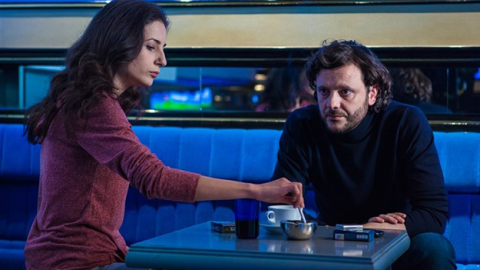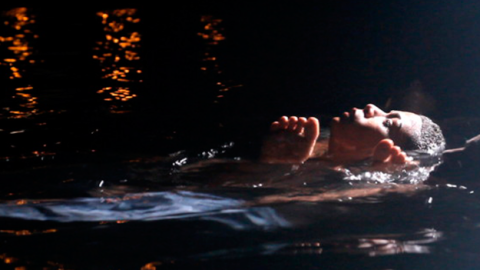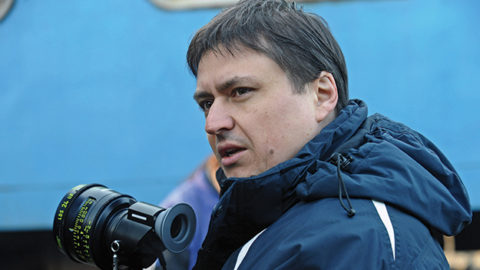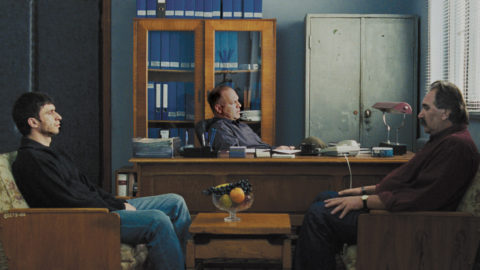Interview: Corneliu Porumboiu
Arguably one of the most consistent directors working today, Corneliu Porumboiu has proven himself to be something like the anchor of the Romanian New Wave, an audacious miniaturist who astounds with his ability to work through the legacy of Romania’s Communist past and the Kafkaesque backwardness of its present.
Porumboiu is perhaps best known here for his (sort of) metaphysical detective comedy, Police, Adjective (09), a sui generis shaggy-dog investigation of language and its relation to the Law. His two most recent features, When Evening Falls on Bucharest, or Metabolism (13) and The Second Game (14), were, ostensibly, formally opposed works: the former was a fiction feature comprised of approximately 19 long takes, charting the plight of a Romanian filmmaker trying to determine where art ends and life begins amid an off-the-set romance with his leading lady; the latter was a found-footage documentary that found Porumboiu and his father discussing the days under the Communist regime while watching a VHS recording of a fateful chapter in the Eternal Derby between the country’s two most popular football clubs, FC Dinamo Bucharești and FC Steaua Bucharești, a contentious and snowy match refereed by Porumboiu’s father. Both films seemed to pick up where Police, Adjective left off in distinct ways that nevertheless bore pronounced affinities, continuing Porumboiu’s engagement with his country’s history and political here-and-now with a singular, deadpan sense of humor and an escalating formal rigor.
His latest, The Treasure, represents an inspired addition to his delightful cinema of contradictions: it is at once hilarious yet rigorous, moving yet droll, patient yet lean, and unapologetically political yet tactful in how it dissects its subject. The story of two neighbors, Adrian and Costi, brought together by a combination of economic circumstance and boredom, who set out to dig up semi-mythical treasure in the backyard of an old family property, The Treasure was one of the highlights of the Main Slate of this year’s New York Film Festival. FILM COMMENT caught up with Porumboiu the morning after the film’s U.S. premiere there. 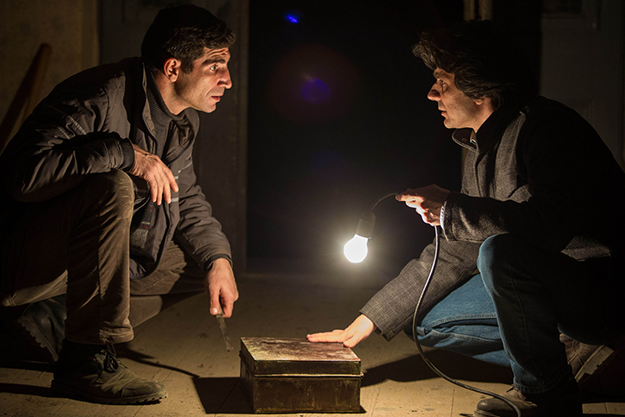
Logically, I wanted to start by having you talk about the origins of The Treasure, because I understand that it began as a documentary but mutated into something else altogether. This is especially interesting in light of the fact that your previous film, The Second Game, was itself a rather unorthodox documentary.
In fact, I started work on The Treasure right after The Second Game because I’ve known Adrian [Purcarescu, who plays the character by the same name in The Treasure] for a long time: he’s also a filmmaker and an actor. He started to make a film 10 years ago, and he acted in, directed and produced that film. So he used to shoot a few days per year. Whenever he had money, he’d shoot another scene from his film, but he never finished it. Years later, he realized that he would never finish it, so at one point I said to him: “Okay. Let’s start to finish it together.” He had like 14 minutes edited from his film and we tried to do something with the footage and complete it without the sequences he never shot.
We started like that, but at one point we realized that it wouldn’t work and for him it was very hard to do it. So we said: “Okay, let’s go.” I knew about the legend of the treasure, so we said: “Let’s go and try to find the treasure.” So I called someone in my hometown that I knew had this company and this metal detector, and the guy came there. And we started to shoot in that garden. I had never gone there before. It was a very fast decision. He told me the story of the garden, and we were shooting nonstop, trying to find the treasure. And at one point, I felt like we were trapped there, like it was a kind of dark hole. Because the garden’s quite labyrinthine in a way, I had a strange feeling.
And after that, when I edited the material back home in Bucharest and looked at it again, I had the same impression, that we were trapped there. I had an instinct: “Okay, I have to do something to get out of here.” So I started to write the script. It started from that garden and what was happening there. Because it really has all this history. The space of the garden was established by the Communists, and afterward it served as a kindergarten, a pharmacy, a drugstore, and after that, it was like a street bar, etc.
And the decision to have your characters find the treasure at the end was a way of redeeming reality through cinema?
Yes, I think so. I had this instinct to get out. That was the first stage. Of course, when you start to write, I think you must have this starting point. From the beginning, it was something fictional, and this notion: “We have to find something.”
Perhaps beginning with When Evening Falls on Bucharest or Metabolism and then on through The Second Game and now with The Treasure, one has the sense that, unlike many filmmakers who expand their scope in a grandiose way as their careers progress and they become more renowned, your focus fascinatingly seems to be both narrowing and intensifying. I was curious if this is something that you think about, this intensive attentiveness to fewer and fewer elements, and whether you consciously impose certain parameters on yourself as an artist.
When I’m making a movie, the first instinct is visceral. That was the case with The Treasure and 12:08 East of Bucharest [06]. First, it’s something that I really want to speak about. Of course, I’m Romanian and I come from a culture which is very in-between, a marginal culture. I’m conscious of that and I want to use it in this way. I am like that. At the same time, I pay a lot of attention to details. Maybe it’s my culture, my way of being which makes me go in that direction. Maybe for my next project, I’ll do something a little bit bigger. But I never think about that. It probably has to do with culture.
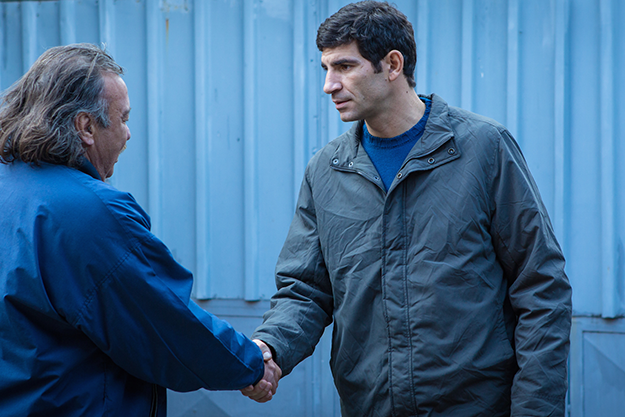
Your way of presenting the narrative in The Treasure seems very concentrated to me. It’s not digressive or all over the place. It feels very hard and nuclear, lean and efficient.
You could see reality from the sky, from the ground level, or you can do a painting-like structure, almost like a work by Kazimir Malevich. Maybe I’m more interested in a microcosmos that reveals other things, you know?
When you were moving away from the documentary origins of the film, did you always have the two male protagonists in mind as the two centers of the film?
For Adrian’s character, yes. When I started to fictionalize the film, I started to think about and write a living character, but I invented the second one. And I did a casting for him.
Could you talk about casting this film?
I knew that Adrian would play Adrian, and I held auditions for the other main actor. So I started the casting and saw a lot of actors. And at one point, I saw Toma Cuzin, who plays the main character, Costi, in a museum with his family. I liked all of them—I liked the contrast between him and his son, the physical appearance of all of them. He’s very thin in a way, and his lifestyle is very stable. So the body language was right. Then I cast the family because I liked the relationships between them, the energy they had together. So I cast all of them.
And for Cornel [the metal detector guy], I also did an audition with actors, and I showed them the documentary footage that I had edited, and I said: “I’m interested in a certain type of body language, and I want to have a character for whom the metal detector is a part of his body.” Cornel [which is also the actor’s name] came in the beginning to explain the metal detectors to the actors. I auditioned the actors, but at some point, I turned to Cornel and said: “Would you like to audition?” And I chose him.
Could you say a bit about directing your actors? I think they obtain this funny, deadpan vibe that’s very unique to your films.
I spend a lot of time casting. And mainly in the casting process, I go through almost the entire script with the actors. It depends on the actors. In this movie, I have a lot of nonprofessionals, like Cornel, the wife, the woman from the bank, etc. But I also have professional actors. With the actors, I usually speak with them about the characters after the casting. I spend a lot of time with them to see what they have in their own biographies, and it’s a long process. After that, I might change the text for them. And when I shoot, I might change it from take to take. I don’t know, it’s a long process. But I always know the tone that I want for their performances.
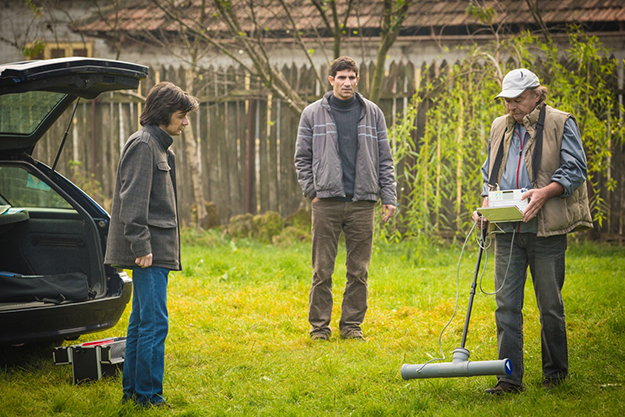
I was wondering how quickly you shoot and how you think the pace of the production informs the final product. With the last few films, one gets the sense that you’re working quite quickly and efficiently, and the films themselves are studies in economy of expression.
We shot The Treasure for four weeks. I’m quite precise about the framing and composition. I know what I want. I don’t do too many takes. But I want my actors to have a certain kind of freedom, so I change a lot of things from take to take. At the same time, we have very good, productive rehearsals beforehand. On set, in a way I want to surprise the actors, as the actors can sometimes get too technical, too mechanical.
For me, a movie is made there on the set, you know? But of course, for every movie that I made, I took out a lot of scenes in editing. This is how I build the pace.
From 12:08 East of Bucharest on, but especially in The Second Game and now here, there’s a kind of political through-line running across the films. This film feels more political than Metabolism, although perhaps you’d disagree. Could you comment on whether you think there’s one strong political thread that unifies your films or if you think if it’s many disparate threads, some of which are present in one film, absent in another, and so on?
There are things that change, even in my perception of and my relation with others. All my movies are political. In Metabolism, I was interested in a certain type of microcosmos which reveals something bigger—but this was also political, in a way. [The protagonist] makes movies and he has this type of limit, which is also a certain type of excuse. So his way of being is the way an artist is in a society and is perceived by a society. It’s political also, no? After all, in Romania, all the funding is provided by the state.
In a way, the threads are separate, but at the same, they are linked. It seems I have an obsession with laws and with the Law. So it’s instinctual that it recurs, you know? But I think it evolves, and my perspective changes. But it remains quite obsessional . . . All my characters are subordinate to something. All my movies are about the concept of freedom. They try to define it. But with each movie I make, I cannot seem to answer a question without opening another question.
That’s a great, honest way to move forward, I suppose.
I don’t know. But it’s not very conscious because, as I told you, I’m inspired by real people and events. I was speaking with my wife about my next project and she started to laugh: “Another one about language?” But it’s not on purpose. Every time we look at things, we look with our own eyes and with our own obsessions.
I wanted to ask you about the final scene, because the entire narrative takes a turn at that point toward something a bit fable-like. But what really interests me is the crane shot there, which is formally quite unlike the rest of the film’s visual style.
I think that the crane shot was supposed to be there from the beginning because I wanted to have a camera movement like in a old movie—a movement out of the story. The movie was also supposed to start with a crane shot, for descriptive reasons, to establish the setting, but I took the scene out. I was of course watching some movies with my team, with the DP, the production designer and all… The Treasure of the Sierra Madre, some genre movies, because in a way… [The Treasure] is a certain type of Western, you know? In a Western, they go to search for a treasure, to conquer a space somewhere. But here it’s funny because they have to conquer the same place each time.
And at one point the guys from my team started laughing because I was saying: “We have to see Full Moon in Paris.” It’s a movie that I love a lot, and we watched it for Police, Adjective and again for Metabolism. And they said: “Again?” That film starts with this type of descriptive shot as well, outside the suburbs of Paris . . . It’s funny, because this movement takes you out of the story normally, but it moves you toward the sun and it’s like another story is starting. I like to have this poetry, not merely to accentuate. Because the film has this fascination with gold—it’s almost like the sun buried in the ground, you know?
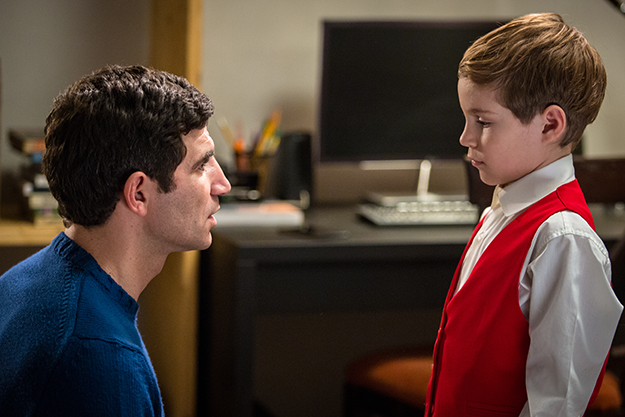
Any other treasure-hunting movies you watched?
No, after that we saw some things that had more to do with natural lighting and mise en scène. It was important at one point to have the sun in the garden, so I wanted for the foreground to be cloudy and for the sun to rise behind this. And the mise en scène is built in a way according to the trajectories of the certain times of the day when we had access just to natural light. So we saw The Stranger by the Lake because Alain Guiraudie was working like that, with natural lighting. I read that in an interview in the Cahiers du Cinéma. He thinks of the movement of the characters in terms of the movement of the sun throughout the day. We did that for this reason, and also for technical reasons, the look on the digital and to find a certain type of frame and colors. What else were we watching? Moonfleet, the Fritz Lang movie. There was a kid there also. What else? After that, I think I was watching things on my own, but I don’t remember right now. For the framing, I knew that I wanted it to be very perpendicular…
Very frontal.
Yes, very frontal. But I think that also, in a way, the texture of the images comes from Full Moon in Paris. Artificial light, too. We wanted to have that to fill in the artificial light in the beginning of the film. Light is very important in this film. And we wanted to have artificial light from above to fill it in a little bit, even in Adrian’s office, even the artificial light in the first part, and after that, you go into the natural light. And after that, in the night, when they’re still searching for the treasure.
Finally, could you talk about your use of Laibach’s rendition of “Life Is Life” over the end credits? Is there an element of irony to the use of that song?
Of course. I’ve known Laibach for a long time. I like it very much and I think the words are very good. They fit in a way because it has a certain type of march-like rhythm. I think I knew from the beginning that I wanted to finish with that song because it has a kind of solemnity… It’s something that’s frightening, but at the same time, has humor and spirals a bit, and the movie [also] has this structure.



